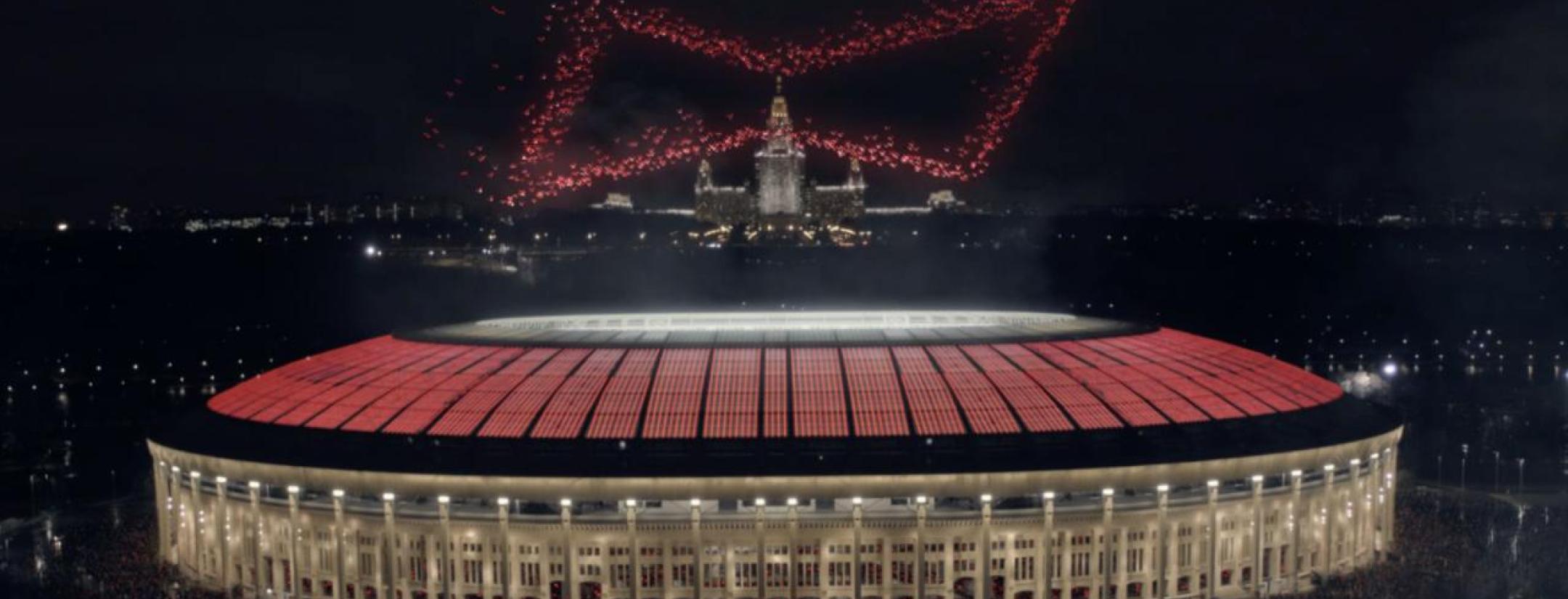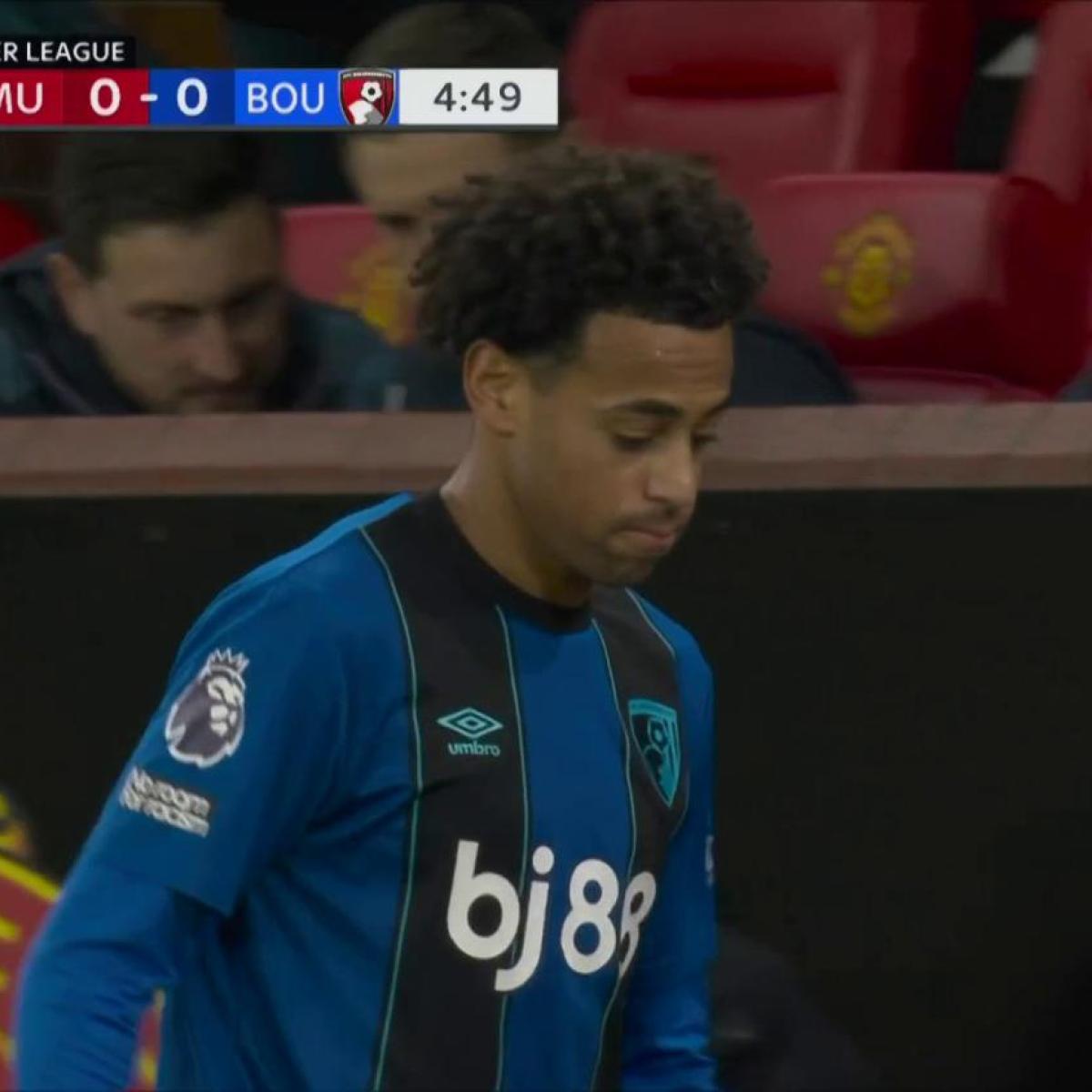We all love new technology and want to know when flying cars and robot servants will arrive like in the Jetsons. But it’s easy to overlook the incremental changes in technology happening right in front of us, right now. The recent Budweiser World Cup campaign gave soccer fans a glimpse into a future where the packaging of everyday objects — beer in this case — could revolutionize how we interact with brands, the world around us and each other.
The story behind Budweiser’s "Light Up The 2018 FIFA World Cup" global campaign is as fascinating as it is innovative. Anheuser-Busch InBev is the world’s largest beer producer, and its Budweiser brand is the official beer sponsor of the FIFA World Cup. So, of course, the company wanted to make a big impression at the 2018 World Cup.
In the United States, Budweiser is to beer what Coke is to soda; it’s ubiquitous Americana. But outside of the country, away from its stars-and-stripes heritage, Budweiser is seen differently. Internationally, Budweiser has successfully positioned itself as a premium beer at the center of the party scene. And premium beers have to constantly remind beer drinkers why they are special. Well in advance of the 2018 World Cup, Anheuser-Busch set out to create the largest integrated marketing campaign in Budweiser history to be launched in Russia during the tournament.
Then Vladimir Putin almost threw a wrench into it.
Luckily, the team at Anheuser-Busch pushed forward and overcame a number of unique obstacles to successfully pull off one of the coolest advertising campaigns we’ve seen surrounding the beautiful game, one that amplifies everything we love about the sport. While we here at The18 aren’t going to throw a lot of marketing speak at you, the 2018 Budweiser World Cup campaign is a story worth telling. And we got exclusive access to a few of the major players who pulled it off.
We spoke with the two guys at the center of the action – Keenan Thompson, Global Director of Innovation for Anheuser-Busch, and Christopher Perkins, Global Director at Budweiser – to bring you the inside story of one of the biggest integrated marketing campaigns in history.
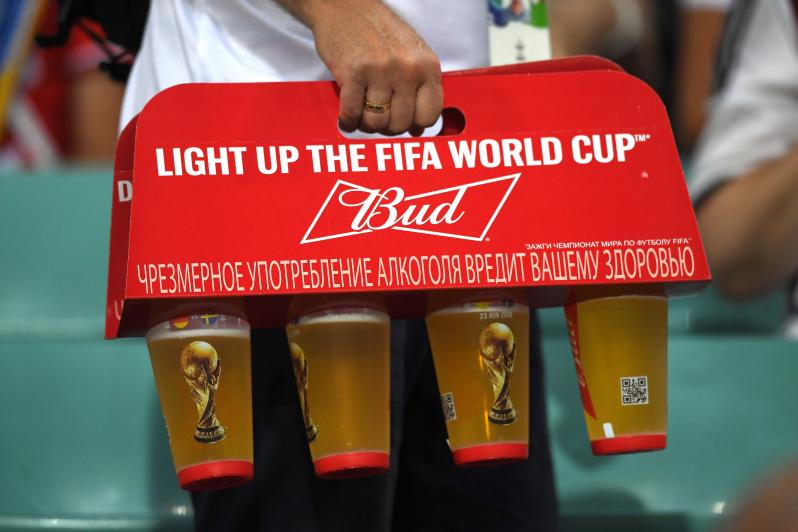
Amping Up A Budweiser World Cup
The Budweiser World Cup campaign began with a single idea: to amplify the euphoric energy fans feel for one amazing month. The World Cup is four euphoric weeks of freedom, as Perkins put it. Wherever this special sense of energy was, Budweiser wanted to be there, ready to make the World Cup even more memorable – whether at home, in a bar or at the tournament in Russia.
“Budweiser’s job is to amplify the euphoric energy the fans feel,” Perkins said. “That’s what we wanted to activate around.”
To do this, Anheuser-Busch called on its Global Innovative and Technology Center (GITEC) in Leuven, Belgium, a unique internal group that basically is to Anheuser-Busch what Q Branch is to James Bond: a research and innovation lab tasked with developing cutting edge technology. Except instead of developing deadly weapons, GITEC develops kick-ass ways to make the beer-drinking experience better.
At this point, several years before the 2018 World Cup, Thompson and the team at GITEC had already recognized smart connected packaging as an exciting technology that could do exactly the kind of thing Budweiser was hoping to accomplish. To put it simply, if your beer cup or bottle could interact with the world around it, it would bring to life an exciting new world of possibilities for brands and consumers. Anheuser-Busch and GITEC were determined to leverage the company's unique capabilities to be at the forefront of this revolution in consumer packaged goods.

After an initial meeting, Thompson and Perkins quickly got excited about the potential for smart connected packaging to be the anchor for Budweiser's 2018 World Cup campaign. They found a reference point in the Budweiser Red Lights hockey campaign in North America, where Budweiser-branded hockey lights and cups lit up red each time a goal was scored for a particular team. A similar product would work wonders at the World Cup in Russia, but there were obstacles. A lot of them.
For starters, hockey is played in an arena with around 20,000 fans. The World Cup is played in giant stadiums with upwards of 80,000 fans. Plus, Budweiser wanted unique cups for each match at the tournament — flags and country names for the group-stage matches and location/round for the knockout stages where participants couldn’t be predicted in advance.
Oh, and there was Russian president Vladimir Putin.
To light up a cup when a goal is scored, a signal must be sent across some sort of frequency in the stadium — and more broadly if you want fans watching in bars to get involved. Frequencies could be anything from WiFi or Bluetooth to radio or infrared. But, if Putin entered a stadium, as he did a number of times throughout the World Cup, nearly all frequencies could be shut down for security reasons.
“If Putin shows up to one of these games they might shut down all the frequencies in the stadium and you can’t communicate to the cup via any of your typical communication methods,” Thompson said.
A wrench indeed.
Building A Solution
While infrared would have been viable, it would have required expensive installations at each venue. The folks at Anheuser-Busch worked around this by creating clever circuit technology to put in each cup. Instead of requiring a specific signal to activate, the cups would light up with crowd noise – a perfect fit with Budweiser's goal to amplify the energy of fans.
Thus, the Budweiser Light Up Cups were born.

Well, not quite. There was still a lot of work to be done.
Foremost was convincing FIFA to allow these cups into every stadium at the 2018 World Cup.
Since the 2010 World Cup was barraged by the buzz of vuvuzelas, FIFA has been wary about what it allows in a stadium. The world football governing body didn’t want a visual vuvuzela to distract from the on-pitch action. Plus, FIFA had a number of technical requirements, such as ensuring the cup couldn’t be taken apart, shattered or otherwise used as a weapon.
While the technical requirements were extensive, Thompson, Perkins and the team worked through them exhaustively. We won't bore you with the details here, but it was a matter of creative engineering, in many cases turning challenges into positives.
Then came convincing FIFA that the Light Up Cups worked during the 2017 Confederations Cup in Russia.
A sort of practice run for the World Cup, the Confederations Cup was the deadline for Anheuser-Busch to have a working design of the Light Up Cups done for FIFA to see. The company put together two versions for the tournament: the type that lit up for each goal and the type that reacted to crowd noise. FIFA decision makers immediately fell in love with the latter, as the cups illuminated with the ebbs and flow of the beautiful game.
“We were lucky enough to be sitting with the FIFA folks at the game,” Thompson said. “They had the cups in their hands and felt it amplify their excitement, helping them enjoy their beer even more. We looked at each other and knew it worked.”
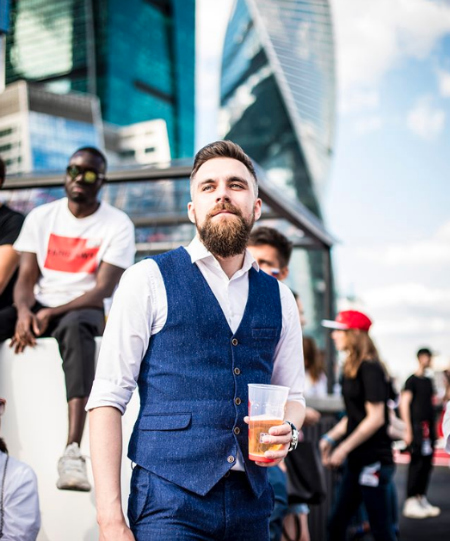
FIFA loved the cups so much, Anheuser-Busch doubled the amount of LEDs in each cup and added a second level of activation, lighting up more brightly as the noise level increased.
Beer cups light up. Like it. @FIFAWorldCup #FifaWorldCup2018 #WorldCup2018 #Semifinals #FranceBelgique #beer #coolstuff #worldcup pic.twitter.com/doI73GGbMS
— M. Caruso-Cabrera (@MCaruso_Cabrera) July 10, 2018
Then came perhaps the biggest hurdle: producing more than 70 versions of the cup for more than 50 countries — more than eight million cups total — in about four and a half months.
“The focus of this was really value engineering so we could make sure this thing was safe, effective, fool proof, could survive the rigors of being moved all around the world and do it with speed to get it in the right place,” Perkins said. “Those were the real challenges: to do that at scale, with speed, with all that logistical complexity is the real victory for us and our GITEC team.”
Even for the biggest distributor of beer in the world, this was a challenge.
The cups were produced and then shipped to the Budweiser distribution centers in Russia, where they were then moved on to the 12 different World Cup stadiums across the country. In a feat of magnificent logistical management, thanks to the work of folks on the Budweiser team, the many different Budweiser Light Up Cups made it to their designated destinations in time to be filled with frothy brew for thirsty fans.
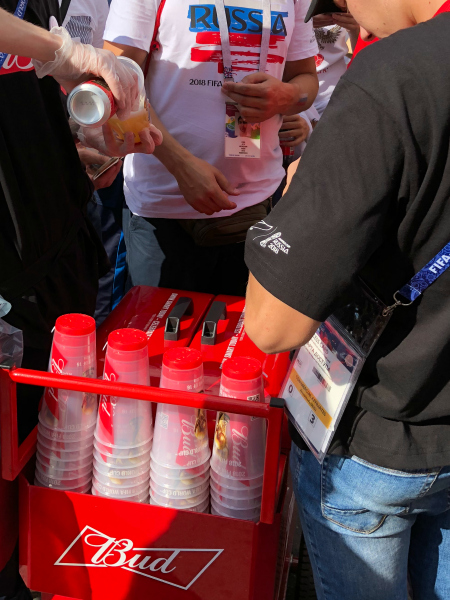
Russian Lights
For anyone who made it to Russia, the Light Up Cups were a smash hit — the comical sight of fans walking out of a stadium with a stack of 20 such cups, trying to collect each and every one of them, served as proof. Budweiser even developed carrying cases to allow fans to carry up to eight beers at once, because of course they did.
The cups even had their own mythology in Russia. With two levels of activation, there were some who believed there was a fabled third level of activation.
“We had people fooling their friends, telling them there was a Level 3, which didn’t actually exist," Thompson said. "One guy told me his friend had been trying for an entire day to hit Level 3. It shows the fun brand interactions technology like this can drive.
"Sometimes consumers are the best innovators."
The Budweiser Light Up Cups made for great souvenirs, with each depicting the match at which the beer was consumed. More beer was sold at World Cup matches than water, according to preliminary numbers.
“What we’ve been more surprised and thrilled with is how the cups look outside of the stadiums at our events, at bars and at people’s homes and how people are reacting to it,” Perkins said.
Not that it was easy to bring everything together.
Thompson was a primary impetus behind the cups for the Budweiser World Cup campaign thanks to his background in both engineering (Bachelors in mechanical engineering) and marketing (Masters in business). He said invention requires everyone to buy in.
“To make innovation happen, you really have to understand the perspectives of all the different stakeholders, whether it’s the supplier, the supplier’s supplier, the person who’s buying from you, the marketing folks, FIFA, senior management, sponsors, technical folks or the community. The only way innovation ever happens is if there’s some sort of positive for everyone involved.”
What’s more, the techniques used to create cups with circuitry could have many valuable applications in the future, from creating unexpected new beer-drinking experiences to supply-chain management and beyond.
“Packaging innovation is an extremely powerful marketing tool, but also one of the more difficult tools to use based on timelines and investment required," Thompson said. "Our role at GITEC is to invent solutions for the beer industry that are not only innovative and desirable, but also feasible at scale.”
More Than Cups
The Budweiser World Cup campaign wasn’t just about cool cups.
Anheuser-Busch collaborated with Twitter to develop a new voting method for the Budweiser Man Of The Match and also launched the first-ever sound-activated Snapchat lens, which mirrored the functionality of the Light Up Cups.
These social media initiatives coincided with Budweiser’s likable drone commercial.
And for those who can’t see the cups light up, Budweiser did something even more special. Three blind soccer fans were given vibrating versions of the Light Up Cups for the World Cup, allowing them to join in on the fun of watching the beautiful game.
The result was increased awareness of Budweiser around the globe, as the brand continues to expand into new markets.
As an example of the success that focusing on soccer has had for Budweiser, the brand recently surpassed Foster’s as Great Britain’s second-biggest beer brand behind Stella Artois, meaning Anheuser-Busch now owns Britain’s two biggest beer brands. And much of the success of the most recent campaign is thanks to GITEC, a group that makes me wish I had an engineering degree so I could join them.
“Anheuser-Busch and GITEC are here to drive the growth of smart packaging and printed electronics," Thompson said. "We are never satisfied. We’re going to stay focused on what’s possible and work with partners to bring amazing new experiences to beer-drinkers.”
Added Perkins: “We’re very lucky to have GITEC. It’s really fun to have them as partners working with us to push ourselves so we’re on the bleeding edge of technology.”
